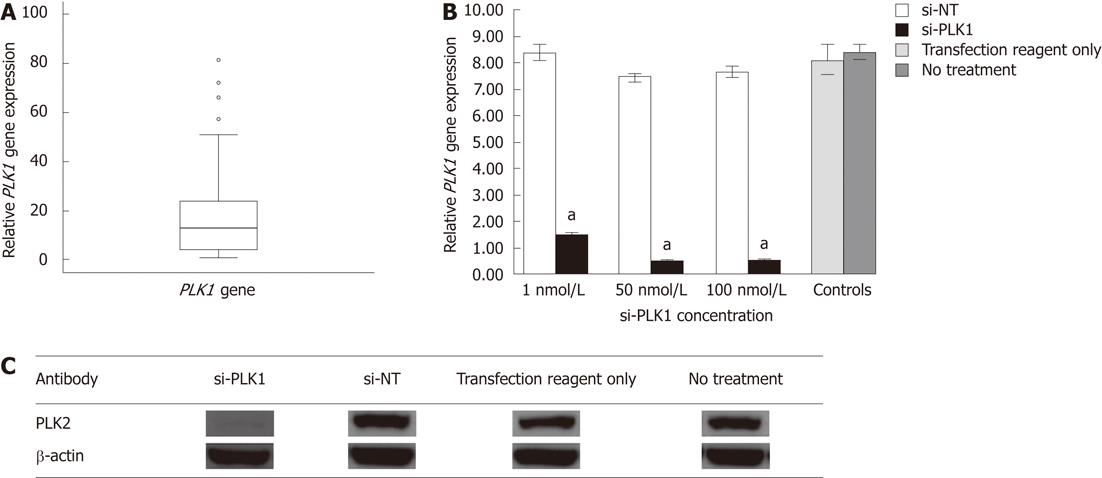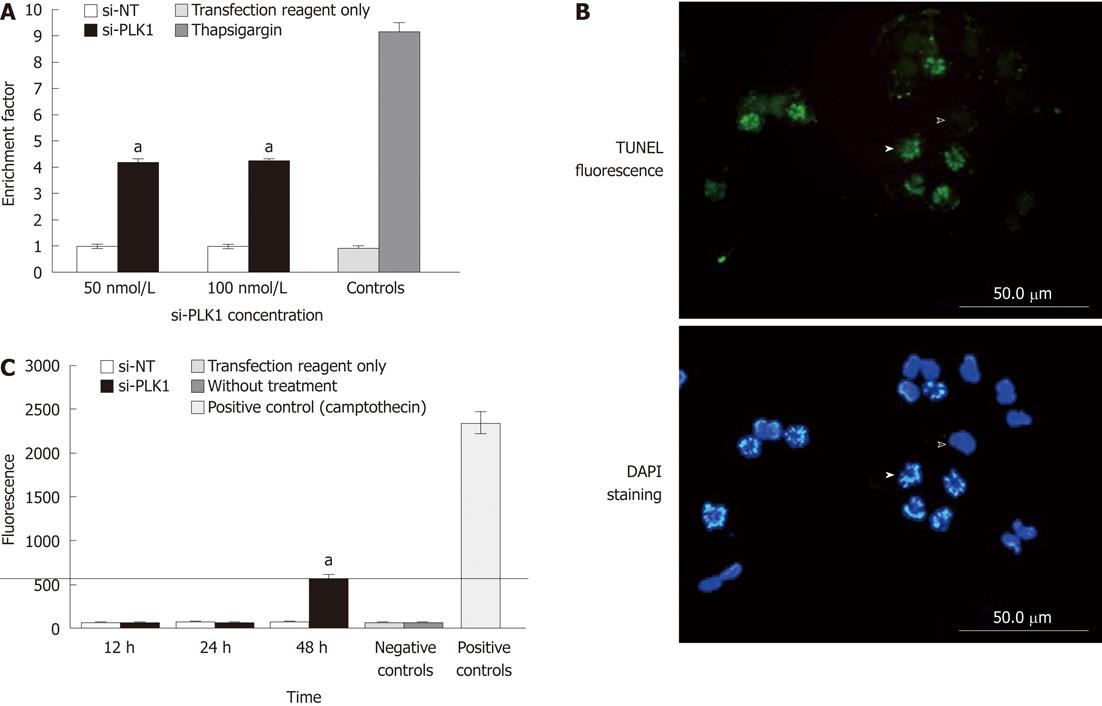Copyright
©2012 Baishideng Publishing Group Co.
World J Gastroenterol. Jul 21, 2012; 18(27): 3527-3536
Published online Jul 21, 2012. doi: 10.3748/wjg.v18.i27.3527
Published online Jul 21, 2012. doi: 10.3748/wjg.v18.i27.3527
Figure 1 Upregulation of polo-like kinase 1 gene expression in 56 hepatocellular carcinoma tumors, efficiency of short-interfering RNA in silencing the polo-like kinase 1 gene, and protein expression in Huh-7 cells.
A: Boxplot showing the minimum, 25th percentile, median, 75th percentile and maximum relative polo-like kinase 1 (PLK1) gene expression. Circles represent statistical outliers. PLK1 gene expression in all hepatocellular carcinoma (HCC) tissue was quantified relative to the non-tumor tissue counterpart using the 2-∆∆Ct method; B: Knockdown with short interfering PLK1 (si-PLK1) at 1 nmol/L, 50 nmol/L and 100 nmol/L successfully silenced PLK1 gene expression (using the 2-∆∆Ct method by quantitative real-time RT-PCR) by 83%, 95% and 96% respectively, compared with short interfering non-targeting (si-NT), or controls. Data shown as mean ± SE, using the Student t-test (aP < 0.05); C: Western blotting showing reduction of PLK1 protein expression in Huh-7 cells, at si-PLK1 and si-NT (non-targeting si-RNA) concentrations of 50 nmol/L compared with si-NT or controls.
Figure 2 Reduction of cell proliferation by 3-(4,5-dimethylthiazol-2-yl)-5-(3-carboxymethoxyphenyl)-2(4-sulfophenyl)-2H-tetrazolium assay and bromodeoxyuridine assay after silencing of polo-like kinase 1, and failure of mitosis after knockdown of polo-like kinase 1.
A: Knockdown of polo-like kinase 1 (PLK1) reduced cell proliferation in Huh-7 cells in the 3-(4,5-dimethylthiazol-2-yl)-5-(3-carboxymethoxyphenyl)-2(4-sulfophenyl)-2H-tetrazolium (MTS) cell proliferation assay by a mean of 65% compared with short interfering non-targeting (si-NT) or controls; B: Knockdown of PLK1 reduced cell proliferation in the bromodeoxyuridine cell proliferation assay in Huh7 cells by a mean of 93% with 50 nmol/L short-interfering PLK1 (si-PLK1) compared with si-NT or controls; C: Confocal fluorescence images show the si-PLK1 transfected Huh-7 cells (left panel) were binucleated, depicting failure in completing mitosis due to the lack of a functional spindle assembly. The right panel shows a functional spindle assembly in Huh-7 cells transfected with si-NT. Huh-7 cells were processed for confocal imaging after 24 h of transfection either with 50 nmol/L si-PLK1 or si-NT; α-tubulins were stained with fluorescein isothiocyanate-conjugated antibody and nuclei were counterstained with 4',6-diamidino-2-phenylindole. Data are shown as mean ± SE, using the Student t-test (aP < 0.05).
Figure 3 Increased apoptosis, apoptosis by terminal deoxynucleotidyl transferase dUTP nick end labeling staining and caspase 3 activity after knockdown of polo-like kinase 1.
A: Increased apoptosis; apoptosis measured by enrichment factor [enrichment factor (sample absorbance/control absorbance) > 1 indicates nuclear fragmentation]. Huh-7 cells transfected with short-interfering polo-like kinase 1 (si-PLK1) showed a 4-fold increase in enrichment factor compared with short-interfering non-targeting (si-NT) or the negative control, no difference was seen between the 50 nmol/L and 100 nmol/L si-PLK1. Thapsigargin (5 μmol/L) treated Huh-7 cells were positive controls. Data are shown as mean ± SE, using the Student t-test (aP < 0.05); B: Terminal deoxynucleotidyl transferase dUTP nick end labeling (TUNEL) fluorescence images showing fragmented DNA labeled with fluorescein-12-dUTP using recombinant terminal deoxynucleotidyl transferase (upper image). The lower image is the corresponding 4’,6-diamidino-2-phenylindole (DAPI) stain showing an apoptotic Huh-7 cell (solid arrowhead) and a non-apoptotic Huh-7 cell (hollow arrowhead). The TUNEL staining colocalized the fragmented chromosomes to apoptotic cells while is absent in non-apoptotic cells with intact chromosomes. Huh-7 cells were processed for fluorescence imaging after 24 h of transfection with 50 nmol/L si-PLK1; C: Caspase 3 activity was measured using a fluorometric immunosorbent enzyme assay from Huh-7 cells transfected with 50 nmol/L si-PLK1 showed no change after 12 and 24 h, with an increase to just over 500 U at 48 h compared with si-NT and negative controls. Positive controls showed values over 2350 U (cell lysates from U937 cells treated with camptothecin, supplied with the kit). Data are shown as mean ± SE, using the Student t-test (aP < 0.05).
Figure 4 Lack of apoptosis protection and caspase-independent apoptosis.
A: Lack of apoptosis protection by pan-caspase inhibitor Z-VAD-FML after knockdown of polo-like kinase 1 (PLK1). The MTS cell proliferation assay in Huh-7 cells transfected with either short interfering non-targeting (si-NT) or short interfering-PLK1 (si-PLK1) in the presence of the pan caspase inhibitor Z-VAD-FMK showed that the pan caspase inhibitor failed to protect si-PLK1 transfected Huh-7 cells from apoptosis. In contrast, HepG2 that were treated with camptothecin and Z-VAD-FMK were protected from apoptosis induced by camptothecin while those treated with camptothecin without Z-VAD-FMK were not protected from apoptosis. Data are shown as mean ± SE, using the Student t-test (aP < 0.05); B: Caspase-independent apoptosis likely due to endonuclease G. Huh-7 transfected with 50 nmol/L si-PLK1 for 24 h was probed with antibody against endonuclease G or apoptosis-inducing factor (AIF) and subsequently visualized with fluorescein isothiocyanate-conjugated secondary antibody (left panels). The corresponding 4’,6-diamidino-2-phenylindole (DAPI)-stained images are shown in the right panels. Block arrowheads and hollow arrowheads mark apoptotic and non-apoptotic Huh-7 cells respectively. Endonuclease G was positively stained in apoptotic cells and colocalized to the fragmented chromosomes (upper left panel), while AIF was found to be absent (lower left panel).
Figure 5 Reduction in hepatocellular carcinoma tumor size with knockdown of polo-like kinase 1.
A: Treatment of short-interfering RNA (siRNA) against polo-like kinase 1 (PLK1) (si-PLK1, n = 6) in nude mice impeded the tumor growth compared with short interfering non-targeting (si-NT) (n = 6) or the non-treatment group (n = 6). Huh-7 tumor-bearing nude mice were treated with 1 nmol/L si-PLK1 intratumoral injections every alternate day for 27 d. Data are shown as mean ± SE, using the Student t-test (aP < 0.05); B: Images of nude mice with their tumors at day 27. The left panel shows a reduction in tumor size of subcutaneous tumors in nude mice treated with si-PLK1, while the right panel shows similar mice treated with si-NT.
- Citation: Mok WC, Wasser S, Tan T, Lim SG. Polo-like kinase 1, a new therapeutic target in hepatocellular carcinoma. World J Gastroenterol 2012; 18(27): 3527-3536
- URL: https://www.wjgnet.com/1007-9327/full/v18/i27/3527.htm
- DOI: https://dx.doi.org/10.3748/wjg.v18.i27.3527













